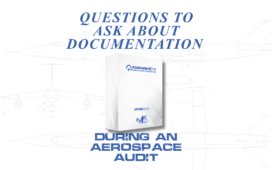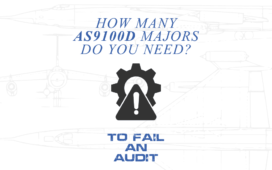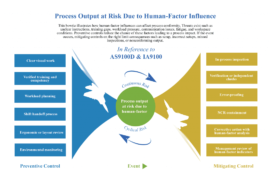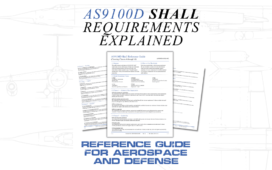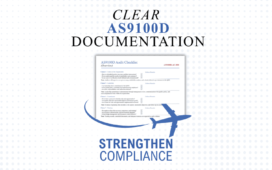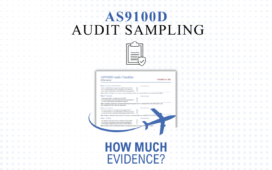Writing clean, accurate, and actionable AS9100 audit finding write-ups is essential for internal audits, supplier assessments, and external certification audits. Poorly written findings lead to confusion, weak corrective actions, and repeat issues. Strong write-ups provide clarity, traceability, and a direct path to effective correction.
This guide explains how to structure AS9100 findings and includes detailed examples you can use as models.
What Makes a Good AS9100 Audit Finding Write-Up?
A correct AS9100 finding should include:
- Clause reference
- Statement of requirement (what the standard says)
- Objective evidence (what was actually observed)
- Statement of nonconformity (why the evidence doesn’t meet the requirement)
- Impact or risk (why it matters)
- Clear, neutral language
This format is used by certified auditors and accreditation bodies.
Example 1 — Document Control (Clause 7.5)
Clause: 7.5.2 – Creating and Updating
Requirement: Documents must be reviewed and approved for adequacy prior to issue.
Evidence: The current “Inspection Procedure QP-14” is missing approval signatures and revision history on the document footer.
Finding Statement: The document does not show evidence of review or approval before issue, which does not meet the requirements of AS9100D clause 7.5.2.
Risk: Use of uncontrolled procedures may lead to inconsistent inspection practices.
Example 2 — Calibration (Clause 7.1.5)
Clause: 7.1.5.2 – Measurement Traceability
Requirement: Measuring equipment must be calibrated at specified intervals.
Evidence: Torque wrench #TW-379 shows a calibration due date of 02/2024; however, it remains in active use as of 11/2025.
Finding Statement: The organization did not ensure calibration was performed within the required interval, not meeting AS9100D clause 7.1.5.2.
Risk: Out-of-calibration tools may produce inaccurate measurements.
Example 3 — Internal Audit Program (Clause 9.2)
Clause: 9.2.2 – Internal Audit Program
Requirement: The organization must conduct internal audits at planned intervals.
Evidence: No internal audit record exists for Q3 2025, although the audit schedule requires quarterly coverage.
Finding Statement: The internal audit program was not followed as planned, failing to meet AS9100D clause 9.2.2.
Risk: Missing audits reduce the ability to identify system issues before external assessments.
Example 4 — Risk Management (Clause 6.1)
Clause: 6.1 – Actions to Address Risks and Opportunities
Requirement: Risks shall be identified and actions defined to address them.
Evidence: The machining department has no documented risks in the 2025 Risk Register, despite three new machining processes introduced this year.
Finding Statement: Risks associated with new processes were not identified or documented, not meeting clause 6.1.
Risk: Unidentified risks may cause unplanned variation or impact product conformity.
Example 5 — Supplier Monitoring (Clause 8.4)
Clause: 8.4.2 – Type and Extent of Control
Requirement: The organization must monitor supplier performance.
Evidence: Supplier SC-221 has no on-time delivery or quality rating recorded for 2025.
Finding Statement: Supplier monitoring records are incomplete, not meeting AS9100D clause 8.4.2.
Risk: Suppliers may deliver nonconforming material without detection.
Example 6 — Production Documentation (Clause 8.5.1)
Clause: 8.5.1 – Control of Production and Service
Requirement: Production must be carried out under controlled conditions, including documented information.
Evidence: Work Instruction WI-33 used in the assembly area is missing required torque specifications for Step 4.
Finding Statement: Production documentation does not contain the information needed for consistent assembly, not meeting clause 8.5.1.
Risk: Incomplete instructions may result in improper torque application.
Use neutral, non-emotional, non-blaming language.
Avoid words like “should,” “might,” “assumed,” “appears,” or “believed.”
Stick to facts, evidence, and exact clause language.
A clean write-up flow is:
- Requirement
- Evidence
- Nonconformity
- Risk
This format is auditor-approved and defensible.
Clear AS9100 audit findings lead to:
- Strong root-cause analysis
- Effective corrective actions
- Shorter closure cycles
- Fewer repeat issues
- Better overall QMS health
- Smoother external audits
Poor findings create weak fixes and recurring problems. AS9100 audit finding write-ups can seem daunting, but when properly documented within well-structured forms, can become strong compliance allies.

Ronnie Lee Roberts II has worked in the Department of Defense (DoD) quality environment since 2017, supporting programs at Patuxent River and Webster Field (NAWCAD/NAVAIR). A certified AS9100:2016 Rev D Lead Auditor (2022–2025), he brings deep knowledge of quality management systems, documentation control, and audit readiness across aerospace and defense operations. His background includes hands-on experience inspecting to specification per engineering drawings and customer requirements, verifying process conformity, and maintaining compliance with AS9100D clauses related to documented information, product realization, and risk management.
In addition to audit work, Ronnie has supported QMS development, technical writing, CAD-based documentation, and controlled record structures that ensure traceability and repeatability. He also holds ISO/IEC 20000-1:2018 Lead Auditor (TPECS, 2023) and Certified CMMI® Associate (2025) credentials, supporting CMMI-DEV Level 3 environments. His focus remains on aligning documentation and inspection practices with AS9100D standards to drive measurable quality performance and readiness for customer and regulatory audits.


